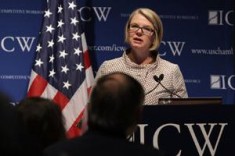Last Friday, President Obama delivered the long-awaited news: it’s the end of No Child Left Behind as we know it. In a short speech delivered to a virtual Who’s Who of the education community, the President announced that NCLB’s uniform, national system of school accountability is no more. It has ceased to be. In its place, the Administration is now offering states the opportunity to receive a waiver from NCLB provided that they agree to adopt certain policies designed to improve student learning. “Our kids only get one shot at a decent education,” said the President. “They cannot afford to wait any longer.”

For those who may not spend their free time obsessing over education policy (i.e., for those who may have a life), some background may be helpful here. No Child Left Behind is the current name we use for Elementary and Secondary Education Act (or ESEA), the federal law that has established federal education policy since it was enacted in 1965. For the past five years or so, a general consensus has emerged among education policymakers and practitioners that NCLB is seriously flawed and in need of fixing. Yet despite this, Congress has moved with molasses-like speed to rewrite NCLB (also referred to as “reauthorizing ESEA”). And so NCLB has continued to be the law of the land, lumbering along like a zombie that no one likes but no one can stop.
Separate but relatedly, two years ago the Obama Administration launched an education-related competition called Race to the Top. To again quickly summarize a somewhat complex policy, under Race to the Top states were invited to compete for federal dollars ($4.5 billion, to be precise) in return for adopting challenging academic standards, focusing on turning around low-performing schools, building useful data systems, and recruiting and training effective teachers and principals. The Department of Education received 46 applications and last September, 10 states and the District of Columbia were awarded grants, and two smaller Race to the Top competitions remain ongoing. And although competitive-grant programs can be politically unpopular – particularly when there are more losers than winners – President Obama remains an enthusiastic supporter of RTT, calling it “the most meaningful reform of our public schools in a generation” in his State of the Union speech in January.
Returning now to the present, the Administration’s waiver proposal (or “ESEA Flexibility” as it’s being called) takes many of the ideas underlying Race to the Top and applies them to kill the NCLB zombie. To receive a waiver, states must have already adopted college- and career-ready standards; develop a plan to identify and improve the bottom 15% of schools (or “priority” and “focus” schools); and develop teacher and principal evaluation systems “based on multiple valid measures, including student progress over time.” In essence, this is Waive to the Top.
In the paragraphs that follow, I’m going to explain why I think the Administration’s ESEA Flexibility plan carries three serious risks. Let me be clear: the risks I perceive are about process, and have little to do with the underlying substance of the policies that President Obama and Secretary Duncan are pushing. Indeed, it’s precisely because the substantive reforms are so critically important that I feel compelled to highlight the dangers that lurk ahead.
1. The Political Risk
The immediate risk facing the Administration’s ESEA Flexibility plan is that political forces will coalesce to oppose and kill it. How likely is that to happen?
At least thus far, I think the Administration has handled the politics around waivers brilliantly. For example, President Obama had Governor Bill Haslam of Tennessee, a Republican, flank him during the announcement of the ESEA Flexibility plan on Friday. This not only lent credibility to the waiver effort – Tennessee has long been seen as a progressive leader on education reform – but also sent a clear and unmistakable signal to Tennessee Senator Lamar Alexander, who introduced legislation naught but two weeks ago to prevent the Department from issuing waivers. The fact that Chris Cerf, the education chief of New Jersey, has already committed his state to applying for a waiver is another huge coup, given the prominence of New Jersey’s governor in GOP circles. To do all this while also obtaining the full endorsement of the National Education Association is no easy feat.
With that said, it is a tired-but-true cliché in politics that the winds can shift quickly. Congressional Republican leaders have not been shy about voicing their displeasure with the waiver plan, chief among them Rep. John Kline, the chairman of the House Education Committee. Likewise, Texas Governor Rick Perry has made no secret of his distaste for Race to the Top, and even attacked Governor Mitt Romney for tepidly supporting RTT in a recent GOP Presidential debate. Might this same criticism bubble up in around waivers? Education rarely is a hot-button issue in Presidential primaries, but if it becomes one, will Republican governors still be willing to play along with the Administration’s efforts? And does anyone know what the Tea Party will think?
Meanwhile, on the left side of the ledger, Randi Weingarten, the influential president of the American Federation of Teachers union, says parts of the all-or-nothing waiver package give her “cause for concern.” Likewise, Governor Jerry Brown of California (my old boss) would no doubt like to see NCLB-related mandates lifted, but will he and California Superintendent of Public Instruction Tom Torlakson accept the new conditions being offered – including those related to the use of student-achievement data to measure teacher and principal effectiveness? Finally, pay close attention to the words of Gene Wilhoit, executive director of the Counsel for Chief State School Officers, who advised the New York Times that “only about five states” could apply now, and “perhaps 20 others could follow by next spring.” If Wilhoit’s right, that means that half the states — including some very big ones, with lots of kids — may end up without a waiver.
Ultimately, the fact that the President himself delivered the waiver announcement yesterday is proof that he and his advisors think this is a winning issue, politically. And if he and Secretary Duncan can continue to control the message – “No more teaching to the test! This means more flexibility for states!” – then they will succeed in winning over the public, and almost certainly secure waiver applications from a majority of states. But if both the right and left flanks peel off, particularly as folks delve into the details of what’s required, the Administration may find itself defending a policy with very few allies while still being forced to tend to the NCLB Zombie. Which outcome is more likely? My Professional Pundit’s Magic 8-Ball says “Outlook Hazy.”
2. The Legal Risk
The next major risk facing the ESEA Flexibility plan: does the Administration possess the actual authority to grant waivers with conditions? Is it, you know, legal? (To answer that question, please bear with me as I remove my policy-director-for-NewSchools hat and pick up my old lawyer-who-defended-the-State-of-California-in-numerous-education-policy-lawsuits hat.)
The first thing to note is that section 9401 of ESEA clearly gives the Secretary of Education the authority to waive NCLB’s accountability provisions, the widely loathed “adequate yearly progress” metric. Specifically, the law requires states to explain how a proposed waiver would “increase the quality of instruction [and] improve the academic achievement of students,” and to “describe, for each school year, specific, measurable educational goals . . . that would be affected by the waiver and the methods to be used to measure annually such progress for meeting such goals and outcomes.”
What section 9401 does not obviously do, however, is provide the Department with the authority to proscribe “the methods to be used” by states seeking a waiver, or to set additional conditions to obtain a waiver. The statute is simply silent on this front. Maybe the Department can restrict in advance what “methods” it deems acceptable – e.g., adoption of common standards, focusing on bottom 10% of schools – but then again, maybe not. Just because something doesn’t say you can’t do something, that doesn’t necessarily mean you can.
What do the courts say about this? Remarkably little, surprisingly. I found virtually no federal precedent grappling with the question of conditional waivers, which in and of itself should raise a cautionary flag. The few state-law decisions that dealt with analogous situations cut against the Department’s position, though to be fair no federal court will feel obligated to follow its smaller, less-respected brethren on this point. For further proof, check out this paper-thin analysis by the Congressional Research Services (go to page 6), wherein they basically throw up their hands and admit they have no idea what’ll happen.
 Moreover, some folks I respect quite a bit believe that because Margaret Spellings (the former education secretary under the second President Bush) also issued conditional waivers, this somehow makes them legal. It doesn’t. State officials do illegal things all the time, it’s simply a question of whether anyone challenges their actions in court. The fact that Secretary Spellings issued waivers with conditions would be marginally helpful to the Department in defending a lawsuit, but certainly not dispositive. (As a further aside, Spellings’ waivers were dramatically different in degree and kind from what Secretary Duncan plans to do here.)
Moreover, some folks I respect quite a bit believe that because Margaret Spellings (the former education secretary under the second President Bush) also issued conditional waivers, this somehow makes them legal. It doesn’t. State officials do illegal things all the time, it’s simply a question of whether anyone challenges their actions in court. The fact that Secretary Spellings issued waivers with conditions would be marginally helpful to the Department in defending a lawsuit, but certainly not dispositive. (As a further aside, Spellings’ waivers were dramatically different in degree and kind from what Secretary Duncan plans to do here.)
So how should a court adjudicate the legality of ESEA Flexibility? Certainly, the goals embodied in the Administration’s proposal synch up nicely with those contained under the current law. It is also a powerful legal defense to point out that states are not obligated to seek a waiver, and may continue instead under NCLB’s accountability regime if they so choose. And the fact that everyone agrees that NCLB is broken and Congress is taking too long to fix it won’t be lost on a judge.
But at the same time, there is a very serious separation-of-powers argument to be made against conditional waivers. “Given that Congress cannot act, I am acting,” said the President last week, but that is not exactly how our tripartite system of small-d democratic government is supposed to work. Consider a hypothetical scenario under which a newly elected Republican President offered waivers to states under the Affordable Care Act, provided they agreed to, say, raise the Medicaid eligibility age, reduce health benefits for illegal immigrants, and defund family planning efforts. Some Republican governors would likely seek (and obtain) such waivers, Democrats would scream bloody murder, and America would drift toward having two separate health-care systems, one red and the other blue.
Do you still think waivers should be legal? Well, do you?
3. The Implementation Risk
Now let us imagine a happy scenario for the Administration, where an overwhelming majority of states have obtained an ESEA waiver, and the skilled attorneys at the U.S. Department of Justice have successfully slain the rash of lawsuits filed around the country. Under such a scenario, the President declare victory and feel confident that our nation’s education system was back on track after years of being terrorized by the NCLB Zombie, right?
Well, no. Because even if the Administration survives the clear-and-present political and legal risks it faces, that will still leave the task of making sure the states actually implement the policies they’ve adopted – and that these policies actually improve the education we provide to our children. To be sure, this is a risk inherent to any change in education policy, but one that (to my mind, anyway) is significantly heightened here. To again put my old-job hat back on, I have seen firsthand how state departments of education can pretend to be faithfully implementing federal law while secretly (or not so secretly) working to undermine it. If the civil servants who are responsible for executing the administration of state education policy conclude that waivers won’t be around for very long, how hard will they work to implement waiver-related policy? How hard would you work on a project if you thought it might be scrapped in a year or so?
* * *
Because this supposed blog post has reached manifesto-like length, my concluding comments will be brief. Politics is a risky business, and while I for one believe the Administration has embarked down a road fraught with political, legal and practical peril, perhaps inaction would be even worse. As the President said yesterday, “Now is the time to once again make our education system the envy of the world.” Failing to do so may be the biggest risk of all.


